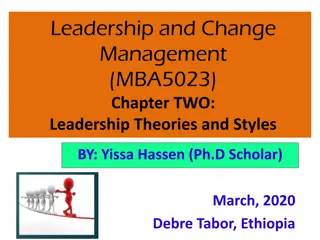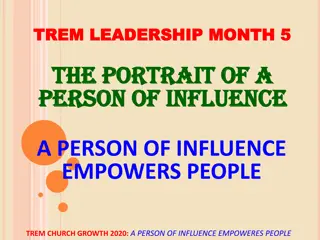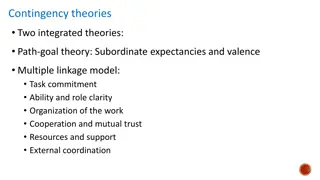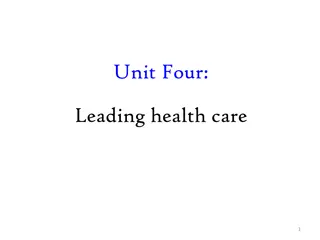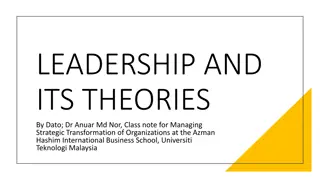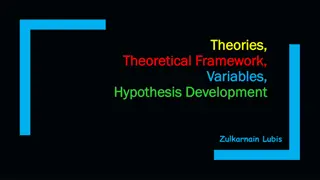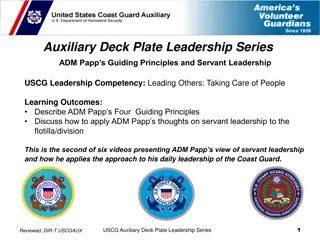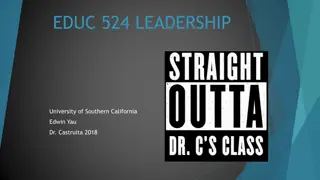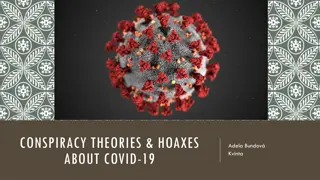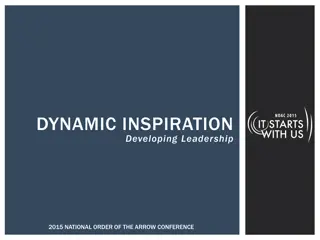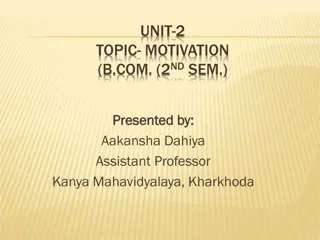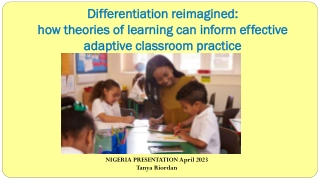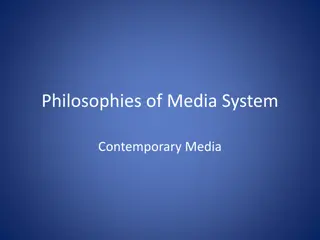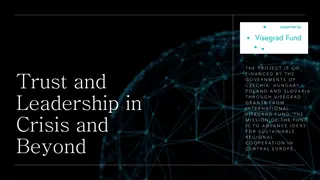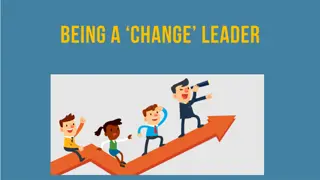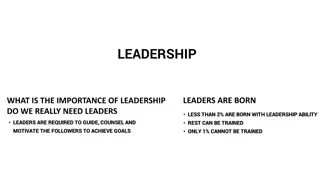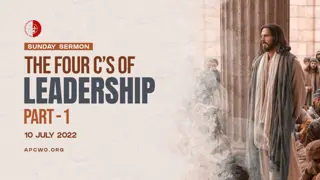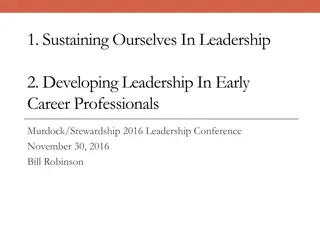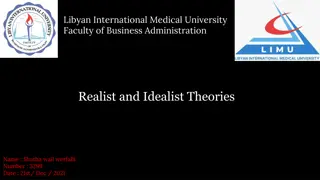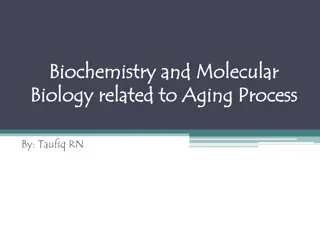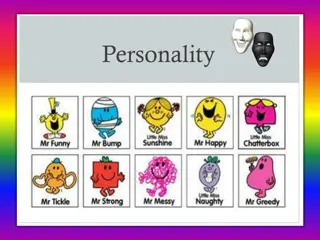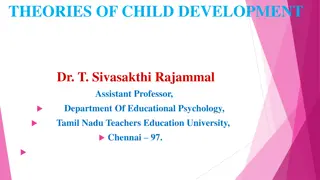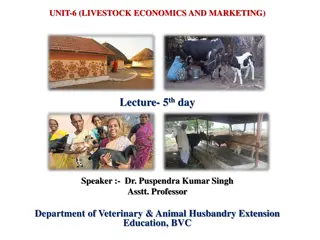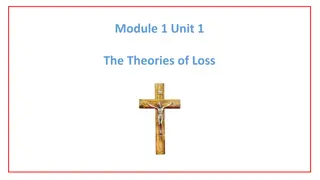Understanding Leadership: Theories, Definition, and Influence
Explore the various theories and definitions of leadership, including how it is a process that involves influencing individuals towards common goals within groups. Leadership is not restricted to designated leaders but is an interactive event that affects both leaders and followers. Influence is essential for effective leadership, which occurs in various group settings, from small teams to entire organizations.
Download Presentation

Please find below an Image/Link to download the presentation.
The content on the website is provided AS IS for your information and personal use only. It may not be sold, licensed, or shared on other websites without obtaining consent from the author. Download presentation by click this link. If you encounter any issues during the download, it is possible that the publisher has removed the file from their server.
E N D
Presentation Transcript
THEORIES OF LEADERSHIP Dr Karina Pilarz
Class No. 1 Organisational issues, basic information about the subject, case studies on leadership.
What do you associate with the word 'leader'? https://www.menti.com/al2kb8whdpgf How to be a leader? https://www.menti.com/alrb1t28gu4n Leadership is . . . https://www.menti.com/alkh2tsnd9pa
How to define leadership? There are almost as many different definitions of leadership as there are people who have tried to define it; the following components can be identified as central to the phenomenon: (a) leadership is a process, (b) leadership involves influence, (c) leadership occurs in groups, (d) leadership involves common goals.
Leadership Leadership is is a a process an an individual individual influences of of individuals individuals common common goal goal. . process whereby influences a a group to to achieve achieve whereby group a a
Defining leadership as a process means that it it is is not characteristic characteristic that that resides resides in in the transactional transactional event event that that occurs occurs between followers followers. Process implies that a leader by by followers followers. It emphasizes that leadership is not a linear, one- way event, but rather an interactive interactive event When leadership is defined in this manner, it becomes available available to to everyone everyone. It is not not restricted designated designated leader leader in in a a group group. not a a trait trait or or the leader leader, but rather a between the the leader leader and leader affects affects and and is is affected and the affected the event. restricted to to the the formally formally
Leadership concerned with how the leader affects followers. Influence is the sine qua non of leadership. Without Without influence, does does not not exist exist. . involves influence influence. It is influence, leadership leadership
Leadership occurs in groups. Groups leadership leadership takes takes place group group of of individuals individuals who a small task group, a community group, or a large group encompassing an entire organization. Leadership is about one individual influencing a group of others to accomplish common goals. Others Others (a (a group) group) are are required required for Groups are Leadership involves who have have a a common common purpose are the involves influencing influencing a a purpose. . This can be the context context in in which which place. . Leadership for leadership leadership to to occur occur. .
Leadership includes attention to common goals. Leaders direct their energies toward individuals who are trying to achieve something together. By By common, common, we followers followers have have a a mutual mutual purpose purpose. . Attention to common goals gives leadership an ethical overtone because it stresses the need for leaders to work with followers to achieve selected goals. Stressing mutuality mutuality lessens lessens the the possibility possibility that followers followers in in ways ways that that are are forced forced or or unethical possibility that leaders and followers will work together toward a common good (Rost, 1991). we mean mean that that the the leaders leaders and and Stressing act toward toward that leaders leaders might unethical. . It also increases the might act
Trait Versus Process Leadership We have all heard statements such as He is born to be a leader or She is a natural leader. These statements are commonly expressed by people people who who take take a a trait trait perspective perspective toward perspective suggests that certain certain individuals inborn inborn characteristics characteristics or or qualities qualities that that make these these qualities qualities that that differentiate differentiate them them from personal qualities used to identify leaders include (e (e. .g g. ., , height), height), personality personality features features (e (e. .g g. ., , extraversion), characteristics characteristics (e (e. .g g. ., , intelligence intelligence and and fluency toward leadership leadership. . The trait individuals have have special make them them leaders, leaders, and from nonleaders nonleaders. . Some of the include unique unique physical extraversion), and fluency; Bryman, 1992). special innate and that innate or or that it it is is physical factors and other factors other
The The trait possessed in varying degrees by different people (Jago, 1982). This suggests that it resides in select people and restricts leadership to those who are believed to have special, usually inborn, talents. trait viewpoint viewpoint conceptualizes leadership as a property or set of properties The The process process viewpoint context context of of the available available to to everyone (Jago, 1982), and can viewpoint suggests that leadership the interactions interactions between between leaders everyone. . As a process, leadership can be observed in leader behaviors can be be learned learned. leadership is is a a phenomenon leaders and and followers phenomenon that followers and that resides resides in in the and makes makes leadership the leadership
Peter Weaver Case Study https://trainingmag.com/leadership-case-studies/ 1. What leadership traits did Weaver exhibit? 2. If you were in Weaver s shoes, what would you have done? 3. Where does courage come from? 4. List your three most important values.
Dealing with a Crisis Case Study https://trainingmag.com/leadership-case-studies/ 1. Explain what you would communicate to the following people: your boss, your Human Resources Department, the local police, the attendees at the conference (Would you continue the conference?) 2. How will you notify Randy s wife? 3. If Randy s wife and a few family members want to visit the location of Randy s death, what would you do? 4. What are some guiding principles that leaders need to follow in a crisis situation?






